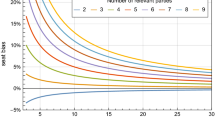Abstract.
In a proportional representation system, apportionment methods are used to round the vote proportion of a party to an integer number of seats in parliament. Assuming uniformly distributed vote proportions, we derive the seat allocation distributions for stationary divisor methods. An important characteristic of apportionment methods are seat biases, that is, expected differences between actual seat numbers and ideal shares of seats, when the parties are ordered from largest to smallest. We obtain seat bias formulas for the stationary divisor methods and for the quota method of greatest remainders.
Similar content being viewed by others
Author information
Authors and Affiliations
Corresponding author
Additional information
Acknowledgement. We thank Friedrich Pukelsheim for many fruitful discussions.
Received March 2004
Rights and permissions
About this article
Cite this article
Schwingenschlögl, U., Drton, M. Seat allocation distributions and seat biases of stationary apportionment methods for proportional representation. Metrika 60, 191–202 (2004). https://doi.org/10.1007/s001840400347
Issue Date:
DOI: https://doi.org/10.1007/s001840400347




